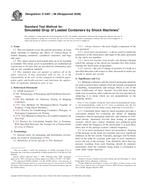1.1 These test methods describe procedures to be followed in testing the performance of permanent metal railing systems (guard, stair, and ramp-rail systems) and rails (hand, wall, grab, and transfer rails) installed in and for agricultural, assembly, commercial, educational, industrial, institutional, recreational, and residential buildings.
1.2 These test methods are applicable to such railing systems and rails having major structural components made of metal, with their secondary components made of metal or other materials such as wood, plastic, and glass.
1.3 These test methods can be used to determine whether permanent metal railing systems and rails comply with anticipated performance requirements of the applicable specifications, codes, and standards, such as those described in Specification E985.
1.4 Specifically, these test methods cover procedures for determining the static strength of metal railing systems and rails as structural elements when installed and fastened to concrete, masonry, wood, and metal as well as related products.
1.5 No consideration is given in these test methods to any possible deterioration of metal railing systems, rails, and connections, resulting from adverse environmental conditions. The performance of special tests covering this aspect may be desirable.
1.6 These test methods are limited to the application of concentrated loads described herein. Whenever given uniformly distributed loads are to be resisted by a railing system or rail in accordance with governing specifications, codes, and standards, the effects of such uniformly distributed loads on the member stresses shall be determined by calculation and the corresponding concentrated loads shall be given consideration during testing and data evaluation.
1.7 Should computations make it possible to provide the needed information, testing can be employed for verification.
1.8 This standard does not purport to address all of the safety concerns, if any, associated with its use. It is the responsibility of the user of this standard to establish appropriate safety and health practices and determine the applicability of regulatory limitations prior to use. For a specific hazard statement, see Note 1.
Product Details
- Published:
- 06/01/2000
- Number of Pages:
- 7
- File Size:
- 1 file , 150 KB


